
 |
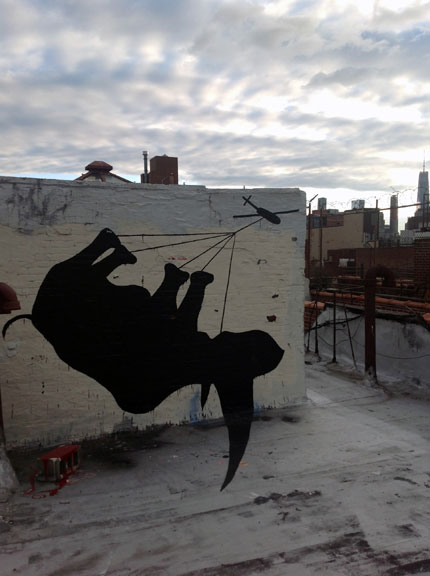
Painted on a tenement rooftop in the East Village, Elasmotherium Airlift also appears in the Missing The Megafauna AR tour at the Metropolitan Museum of Art where it is triggered by Tiepolo's Allegory of the Planets and Continents. Here is the accompanying script:
Bound in the talons of the thumping beast, the sky approaches yet yields no foothold. My legs have gone slack, no feeling, no motion, my toes are unrecognizable without the grasses underfoot.They are right you know, my great horn can cure many ills. Its radiance brings order to disharmony. Across the savannah all must give and take care and all understand that the horn is an expression of the animating grasses. Its power is non-transferable. That should be obvious. But home is receding. I no longer hear the cries of my young and must ask, is this the best that can be done?
This work, Elasmotherium Airlift, depicts the black silhouette of a Pleistocene-epoch rhinoceros (Elasmotherium sibiricum) strung upside down by ropes from an airborne helicopter. The reference is to the current conservation practice of airlifting rhinos to safer, less poachable areas of South Africa and Botswana. The method of lifting the massive creature by its ankles ostensibly places less stress on the animal than if it were bouncing around, anesthetized, in a truck.
The black silhouette format used in this work evokes and pays tribute to the Shadowman paintings of Richard Hambleton – iconic presences of absence in the 1980s streets of NYC.
On the tenement building rooftop, the gigantic horn of the elasmotherium transgresses a division between the wall’s vertical plane and the horizontal plane of the roof. To visually align the image across these perpendicular planes requires standing in a precise spot. Following the elasmotherium’s apparent flight path from this view means the helicopter ascends into the same sight corridor in the New York City sky where 3000 people perished in the World Trade Center tragedy. The implication is that the plight of the rhinoceros genus might be analogous to our own and that the decisive component of a preservation-driven airlift isn’t getting aloft, it’s finding a safe place to set down. Hauntingly for the elasmotherium, there was no landing pad, even over the horizon.
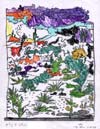 |
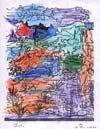 |
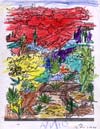 |
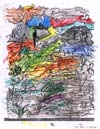 |
 |
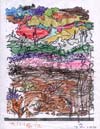 |
 |
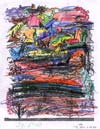 |
 |
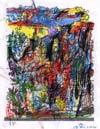 |
 |
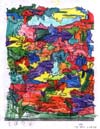 |
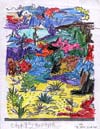 |
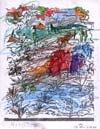 |
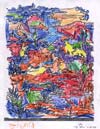 |
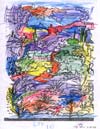 |
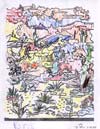 |
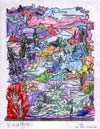 |
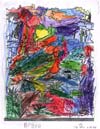 |
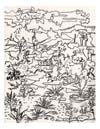 |
Today, I’m honored to introduce the estimable offerings of a group of newly emergent artists: a class of four and five year old pre-schoolers.
For the fourth year running, a wonderfully dedicated and inventive Scottsdale teacher has used a drawing of mine as the central exercise for a month’s worth of surprisingly sophisticated art projects and lessons. (For an expanded description of the teacher’s lesson plans, see the project’s premiere post).
The students worked on these drawings for short, intense periods over several days. They took their time, refining their vision in the manner of creating a masterpiece.
During my recent stay in Arizona (while I painted Burro Train and Canyon Ascent), I had the great pleasure of visiting this class and presenting a painter’s tools and practices to the students. In exploring their works, I realize that I love each and every piece entirely and uniquely.
This openness of heart is a tribute to the fulfilled artistry coursing through each of these fresh observers, not to mention the ideal state for perceiving art.
The teacher explained on the morning of my visit how, at the conclusion of the project, their drawings would be posted on the internet where anybody, “even the President of the United States,” could view them.
That’s a happy notion: a President scheduling time for some inspiring beauty.
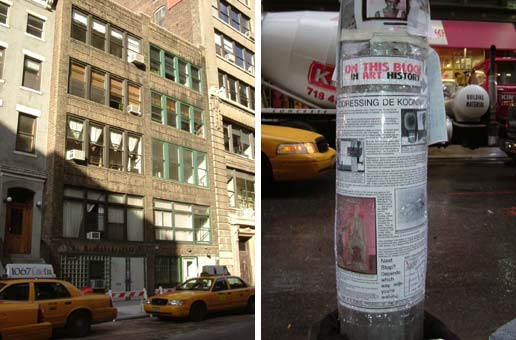
TINSQUO’s Fall street installation Addressing de Kooning has a new addition, a prequel. During the WPA’s Federal Arts Project years of the mid-1930s, it turns out de Kooning shared the block with what is now the School of Visual Art's West Side Building on W. 21st Street.
While in that studio, he did what many an SVA student has done or will do on that very block - he declared himself an artist: “...it was really more of a psychological attitude: that it was better to say No, I’m an artist. I have to do something on the side to make a living...it was a much better state of mind.”
So, now there’s a new reason to continue your stroll back in time - from the East Village studios of an AbEx giant to the humble Chelsea lofts of a mere beginner. If you are unable to stroll the self-guided Addressing de Kooning walking tour, you can always take a virtual promenade via the PDFs below:
143 W. 21nd Street
156 W. 22nd Street
85 4th Avenue
88 E. 10th Street
831 Broadway
 |
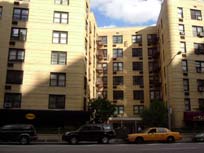 |
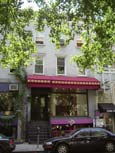 |
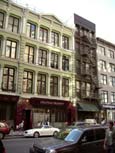 |
Giants walk among us and within us - in memory, in knowing. Those of us fortunate to walk the streets of New York City stroll amidst the hovels that sheltered such giants every day.
“...I have some feeling about all these people - million[s] of them - on this enormous track, way into history. They had a peculiar way of measuring. They seemed to measure with a length similar to their own height. For that reason, they could imagine themselves in almost any proportions.”
In his essay “The Renaissance And Order,” Willem de Kooning (1904-1997) famously described a particular historical through-line, what he called “a train track in the history of art that goes way back to Mesopotamia.”
The photographs above offer a present-day portal to key locations of New York City painting studios in the story of de Kooning and, by extension, the story of Art’s history.
Dreams of possibility abound behind every window, in the face of every passerby and in the persisting relics of those who trailblazed Art’s track from Mesopotamia to Gotham’s metropolis. De Kooning constructed his paintings of such glimpsed dreams - allowing previous incarnations, traces of discarded tangents and struggle to remain visible in his finished compositions. Much of his work’s lingering power derives from this honoring of each painting’s history and the history of the painter who painted it.
Right now on the streets of Lower Manhattan, in blocks that bear the address of de Kooning’s principle New York studios, you’ll find an installation (most days) displaying a temporary, unofficial art historic registry. Four placards (more locations as time permits) describe some of what transpired in the respective de Kooning address. Each poster is like an open window, beckoning passers-by into the process and works that emerged from de Kooning's studios.
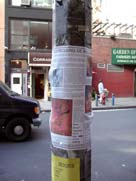 |
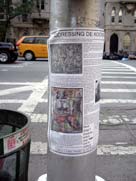 |
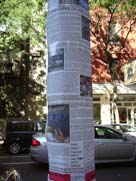 |
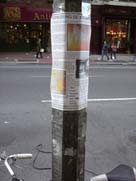 |
Below are PDFs of the posters.
143 W. 21nd Street
156 W. 22nd Street
85 4th Avenue
88 E. 10th Street
831 Broadway
The project is a way to concretize the profound, evanescent memories these coordinates possess. Think of it as public service graffiti - freshly installing the paintings of one giant into the world of daily experience from which they came so we, the People, can walk among them.
If you won’t be in NYC during the nuanced, crackling days of Fall, take your own virtual tour of the neighborhood with the PDFs above.
This project acknowledges and owes much to the excellent biography, de Kooning: An American Master by Mark Stevens and Annalyn Swan.
 |
 |
 |
 |
 |
 |
 |
 |
 |
 |
 |
 |
 |
 |
 |
This post represents the first collaborative project at tinsquo.com and, in regards to the quality of the artists involved, sets a high benchmark for all future endeavors. The works above are the creations of the fourteen 4 and 5 year olds in Mrs. P’s and Mrs. F’s pre-school class.
During a January visit to Arizona, I became the subject of “Show and Share” for my host family’s daughter at preschool. As a result, Mrs. P and her assistant, Mrs. F, suggested the possibility of the kids seeing one of the drawings my young hostess described to her class. One such drawing was selected and, soon, an inspired project was underway.
Who better to collaborate with than the youngest artists among us?
While I made inkjet prints to offer in service to each student’s creativity, Mrs. P used the internet to improvise an ingenious series of lesson plans dedicated to art. She introduced these fresh, four and five year old minds to some of the varied ways people have seen and represented the world by researching on-line and printing images of various artist’s works and styles. (Now, that is teaching!)
Each week, a new artistic tradition would swirl into the classroom: The Cubism of Picasso prompted the use of circles, squares and triangles to form faces, trees and fruit bowls; Alexander Calder's mobiles were simulated with pipe cleaners and construction paper; looking at Braque offered an ocassion to make collages; upon learning about Leonardo Da Vinci, the students drew their own take on the Mona Lisa.
The Seurat presentation on Pointillism resulted in dot drawings from the students and, later, prompted one of them to remark to her mother, “Look Mommy, there’s little dots in the tv just like the painter we talked about today...pointy.”
The desert landscape of the original drawing is a depiction of these childrens’ home minus the human footprint. Its complexity and detail motivated Mrs. P to have the children work on their pieces over the course of a couple of months. This process brought a refined element to the childrens’ work that we usually think of as being uniquely adult: resolution.
Every week or two, their “artist’s drawings” would be brought out and the kids would continue their work, discovering new details, taking their time. The result is a rarity, an extended work from each five year old completed in the “Masterpiece” tradition - unhurriedly, over a protracted period of time.
The diverse approaches among these fourteen young artists represent pure examples of Action Painting: an artmaking practice where meaning is most reliably discovered and conveyed in capturing the movement of the body. For us as viewers, tracking those pivoting elbows and investigating hands over the surface of each piece rekindles our own bodies and hearts to the same liberty of color-filled expression. From broad sweeps of the shoulder that yield energetic “scribbles” all the way down to each carefully rendered issuance from the fingertips, beauty is a function of variety.
Today’s post is an honor. I love every one of these drawings with totality and delight. My thanks to the artists and all those who enabled this happy turn of events. Anything else I might say is superfluous. These young artists speak with perfect eloquence, themselves.
 |
 |
 |
 |
 |
 |
 |
 |
 |
 |
 |
 |
 |
 |
 |
This post represents the first collaborative project at tinsquo.com and, in regards to the quality of the artists involved, sets a high benchmark for all future endeavors. The works above are the creations of the fourteen 4 and 5 year olds in Mrs. P’s and Mrs. F’s pre-school class.
During a January visit to Arizona, I became the subject of “Show and Share” for my host family’s daughter at preschool. As a result, Mrs. P and her assistant, Mrs. F, suggested the possibility of the kids seeing one of the drawings my young hostess described to her class. One such drawing was selected and, soon, an inspired project was underway.
Who better to collaborate with than the youngest artists among us?
While I made inkjet prints to offer in service to each student’s creativity, Mrs. P used the internet to improvise an ingenious series of lesson plans dedicated to art. She introduced these fresh, four and five year old minds to some of the varied ways people have seen and represented the world by researching on-line and printing images of various artist’s works and styles. (Now, that is teaching!)
Each week, a new artistic tradition would swirl into the classroom: The Cubism of Picasso prompted the use of circles, squares and triangles to form faces, trees and fruit bowls; Alexander Calder's mobiles were simulated with pipe cleaners and construction paper; looking at Braque offered an ocassion to make collages; upon learning about Leonardo Da Vinci, the students drew their own take on the Mona Lisa.
The Seurat presentation on Pointillism resulted in dot drawings from the students and, later, prompted one of them to remark to her mother, “Look Mommy, there’s little dots in the tv just like the painter we talked about today...pointy.”
The desert landscape of the original drawing is a depiction of these childrens’ home minus the human footprint. Its complexity and detail motivated Mrs. P to have the children work on their pieces over the course of a couple of months. This process brought a refined element to the childrens’ work that we usually think of as being uniquely adult: resolution.
Every week or two, their “artist’s drawings” would be brought out and the kids would continue their work, discovering new details, taking their time. The result is a rarity, an extended work from each five year old completed in the “Masterpiece” tradition - unhurriedly, over a protracted period of time.
The diverse approaches among these fourteen young artists represent pure examples of Action Painting: an artmaking practice where meaning is most reliably discovered and conveyed in capturing the movement of the body. For us as viewers, tracking those pivoting elbows and investigating hands over the surface of each piece rekindles our own bodies and hearts to the same liberty of color-filled expression. From broad sweeps of the shoulder that yield energetic “scribbles” all the way down to each carefully rendered issuance from the fingertips, beauty is a function of variety.
Today’s post is an honor. I love every one of these drawings with totality and delight. My thanks to the artists and all those who enabled this happy turn of events. Anything else I might say is superfluous. These young artists speak with perfect eloquence, themselves.
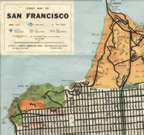 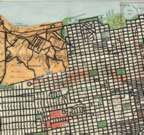 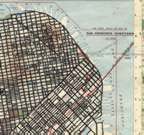 |
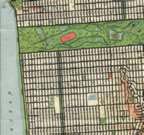 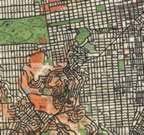 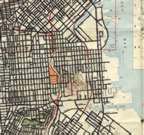 |
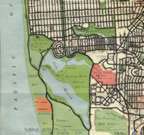 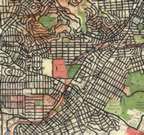 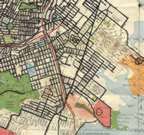 |
After the San Francisco Chronicle printed this, I figured it was high time I posted the above...you know, just for the record.

"nearly_show_share"
Today's post is currated by the discerning eye of a four and a half year old. While traveling, I was graciously welcomed into the family home of beloved friends in Pheonix. My prescence there became the pre-school "Show and Share" subject of the family's oldest daughter.
Reports are that "Alice" described me as "an artist who takes walks in the desert and makes drawings." When asked what the drawings look like, her succinct answer, "swirly."
My young friend's presentation resulted in her getting some pre-school homework, namely to see if she might be able to bring in one of those "swirly" drawings to share with the class.
Could there be a more desirable audience than a classroom of 4 year olds? Eyes whose youthful survey is fresh and without judgement. Perception independent of aesthetics.
I did, however, call upon Alice to make a critical assessment: to select which drawing she would like to take to class and show her friends. After removing images that might be regarded as disturbing, I offered her many drawings from which to choose. The above posted drawing drew her immediate and unwavering enthusiasm. "That's the one I want to take to school," she said.
The piece is unique in the works I showed Alice in not featuring a human figure, and is easily the most representational drawing I made during my stay in Pheonix (possibly the most representational drawing I've made in 15 years!). It could, essentially, be the view out the back of her family's home. (Actually, I made it sitting across from the Convention Center in downtown Phoenix.)
Addendum: Happily, I can report that, in today's unveiling, the drawing earned winning approval for itself and its presenter. In fact, the story may well continue, for the teacher plans to make photocopies of the drawing for the kids to color and then send to the "artist."
I'll keep you apprised.